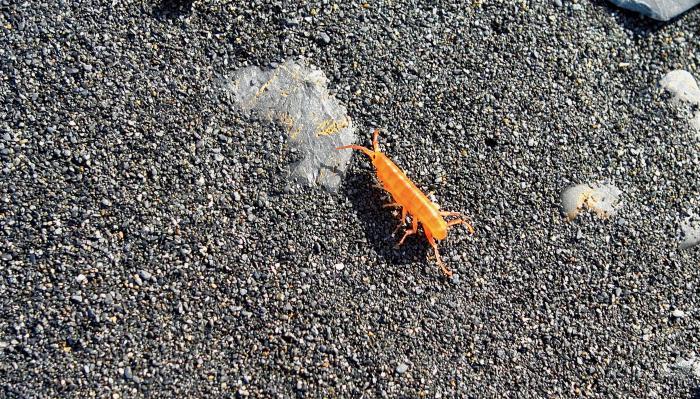Beach Flea, Jumping Jack — Kumitgaq
Taqukarat kumitgarturtaartut. – Bears always eat jumping jacks.

Beach flea on the coast of Kodiak Island, AM725.
Beach fleas are a common resident of Kodiak’s coast, from the intertidal zone to the ocean depths. There are many varieties of these tiny crustacea adapted to different environments. Some like brackish water and live in lagoons. Others prefer to hang out under driftwood or kelp in the intertidal zone. Still others burrow into sand or even live on king crabs.
One thing many of the species have in common is their resemblance to shrimp. Although less than an inch long, the typical beach flea has a long abdomen covered by a cylindrical, segmented exoskeleton, with spindly legs, and prominent antennae. The Alutiiq word for shrimp—qumitgarpak—comes from the word for beach flea. It means big beach flea!
Kumitgat are an important source of food for fish, birds, and even foxes and bears. Bears forage along Kodiak beaches for marine algae and beach fleas and will even dig into the beach and turn over rocks to find the creatures. This is particularly common on the Aliulik Peninsula, where high densities of bear and limited berry crops encourage bears to eat from the beach.
For fishermen, beach fleas are a nuisance. Ravenous fleas eat the bait out of crab pots and even devour fish caught on long-line gear. These small creatures are also annoying to campers and picnickers because of their ability to jump. Kodiak Islanders often refer to these beach fleas as jumping jacks or hoppers because they will fling themselves at people.
One thing many of the species have in common is their resemblance to shrimp. Although less than an inch long, the typical beach flea has a long abdomen covered by a cylindrical, segmented exoskeleton, with spindly legs, and prominent antennae. The Alutiiq word for shrimp—qumitgarpak—comes from the word for beach flea. It means big beach flea!
Kumitgat are an important source of food for fish, birds, and even foxes and bears. Bears forage along Kodiak beaches for marine algae and beach fleas and will even dig into the beach and turn over rocks to find the creatures. This is particularly common on the Aliulik Peninsula, where high densities of bear and limited berry crops encourage bears to eat from the beach.
For fishermen, beach fleas are a nuisance. Ravenous fleas eat the bait out of crab pots and even devour fish caught on long-line gear. These small creatures are also annoying to campers and picnickers because of their ability to jump. Kodiak Islanders often refer to these beach fleas as jumping jacks or hoppers because they will fling themselves at people.
